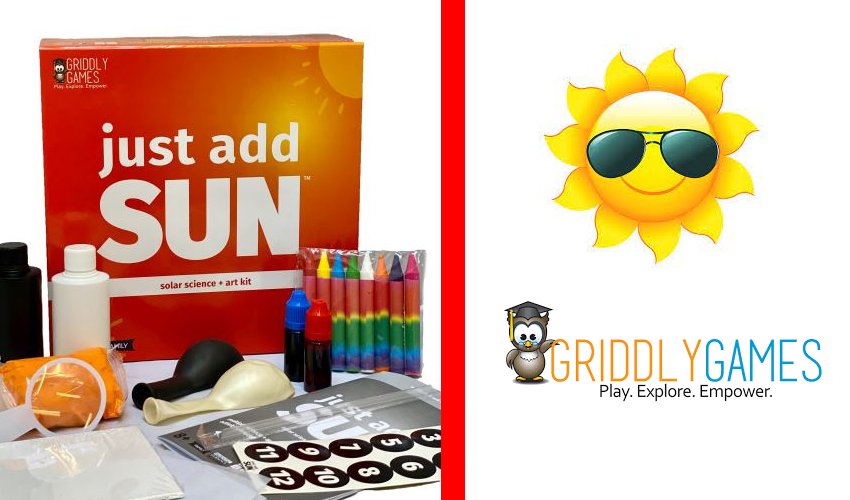Have you ever heard of Genius Hour? Genius hour is a new approach to learning where students get to explore there own interests, knowledge and curiosity in a set amount of time, which is normally an hour a week. Towards the end of the school year Genius Hour was talked about in my daughter’s grade two class. Miss P took an interest in wanting to learn about the sun. For example: Where does the sun go at night? How hot is the sun? To assist her in her passion for knowledge pertaining to the sun I introduced her to Just Add Sun STEAM Kit from Griddly Games. Just Add Sun comes with instructions and tools for doing hands-on activities that use the power of the sun. She was able to see how the energy of the sun can be used for heating and cooking, and experiment with light, heat transfer, reflection, and more!
Melting ICE STEAM Activity
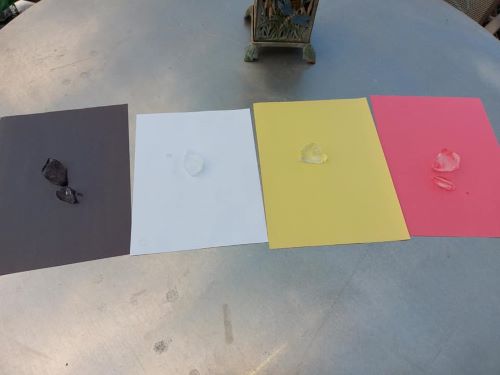
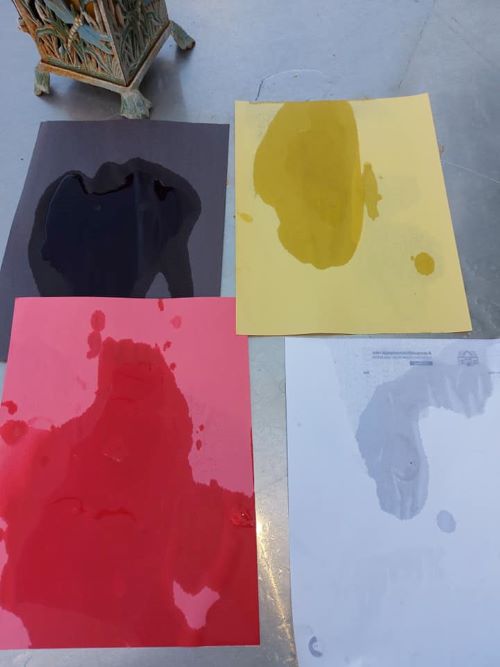 You will need four pieces of colored paper. We used black, red, yellow and white. Place one ice cube on each sheet of paper outside in a sunny location. Set a timer and check back periodically until the ice cubes have melted
You will need four pieces of colored paper. We used black, red, yellow and white. Place one ice cube on each sheet of paper outside in a sunny location. Set a timer and check back periodically until the ice cubes have melted
Different colors reflect and absorb the sun’s energy differently. Miss P made a prediction that she thought the ice on the red paper would melt first. However, she quickly discovered that dark materials absorb more of the visible spectrum of light which is then converted to heat. Therefore, the ice on darker color paper melts quicker then on light paper. The ice cube on the black paper melted in under 5 minutes. Knowing what my daughter now knows about colors and heat I asked her who she thought was dressed cooler- her or I. She was wearing dark blue and I was wearing a light color. She chose me. With knowledge about colors and heat absorption, she can now plan her wardrobe to correspond with the weather. This was definitely a simple, but fun activity.
Melting Ice & Salt Science Experiment
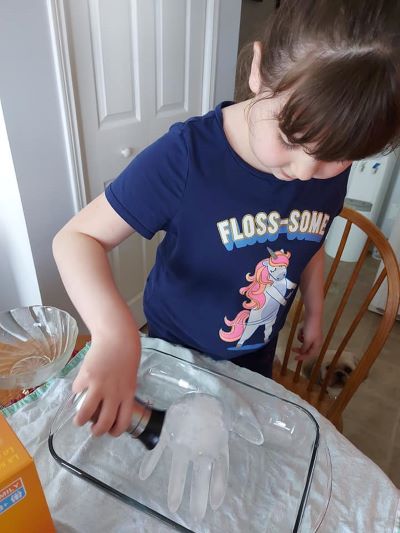
This STEAM activity is perfect for any time of the year! We filled a glove with water and placed it into the freezer over night. The next day we cut the glove away 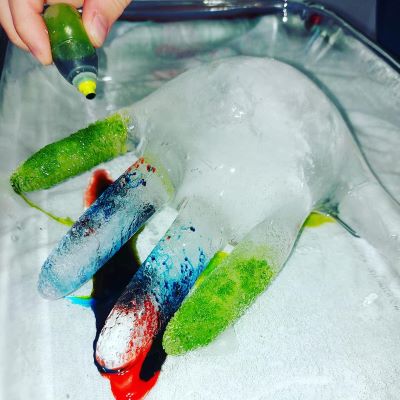 from the ice hand and sat the hand into a shallow dish. Miss P added salt to two fingers and the thumb and food coloring to two fingers. Right away you could hear the ice begin to crack and see the salt begin to create tiny craters on the thumb and two fingers. We then added food coloring to the salted ice fingers too. It was really interesting to watch. As we added more salt to the fingers it speed up the melting process and the fingers fell off. Salt lowers the freezing point of the salted ice fingers, making it melt quicker than the unsalted food colored ice fingers. This is a fun way to introduce STEAM to your kids. Miss P enjoyed the activity so much she asked to do it again.
from the ice hand and sat the hand into a shallow dish. Miss P added salt to two fingers and the thumb and food coloring to two fingers. Right away you could hear the ice begin to crack and see the salt begin to create tiny craters on the thumb and two fingers. We then added food coloring to the salted ice fingers too. It was really interesting to watch. As we added more salt to the fingers it speed up the melting process and the fingers fell off. Salt lowers the freezing point of the salted ice fingers, making it melt quicker than the unsalted food colored ice fingers. This is a fun way to introduce STEAM to your kids. Miss P enjoyed the activity so much she asked to do it again.
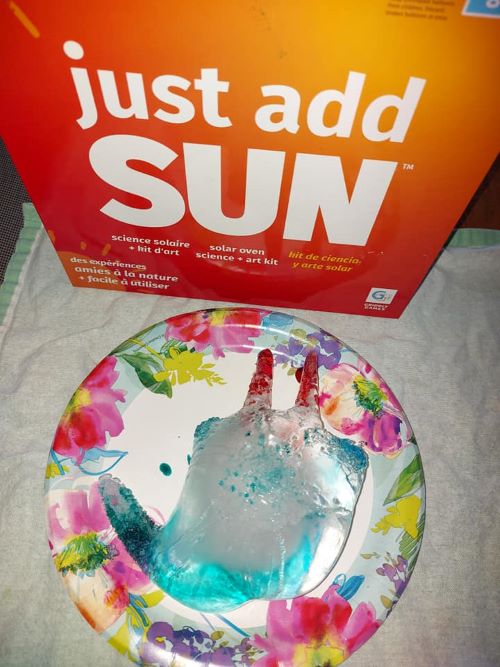
Mystery Pop Balloon
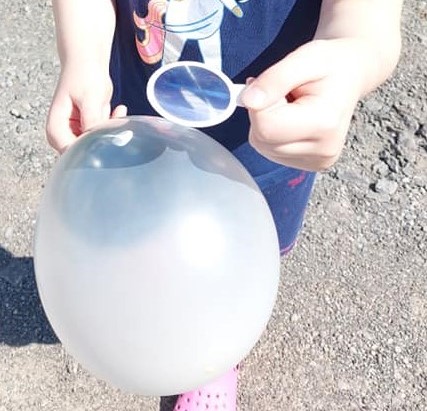
Blow up the clear balloon, but do not tie off the open end.
Partially insert the black balloon into the clear balloon. Make sure the opening to the black balloon is still accessible.
Blow up the black balloon until it is about half the size of the clear balloon and tie off the black balloon. Once tied off, push the black balloon the rest of the way into the clear balloon and tie off the clear balloon.
Use the magnifying glass to focus sunlight on the black balloon inside. The black balloon pops!
When you use a magnifying glass to focus the sun’s rays into a dot, you create a spot that is incredibly hot. It’s the perfect way to start a fire (literally). Why is only the black balloon popped?
Luckily, for the clear balloon, most of the light and its heat, pass right through the balloon’s surface. You’ve seen this in action before. When you look through glass windows, a clear drinking cup, or even a pair of glasses, you’re witnessing light passing through a surface. Since the clear balloon is nearly transparent, the same thing happens when it is exposed to light, even in a high concentration.
The black balloon isn’t so lucky. When we’re talking about light, black is created by a surface that doesn’t reflect any light… it absorbs almost all of it. This “absence” of reflected light creates the black color we perceive. With a surface absorbing all of that light, it also absorbs the energy. In this case, that energy is heat, and a lot of it. The heat absorbed by the black balloon from the focused sunlight quickly causes the bonds of the balloon to weaken until it can no longer contain the air on the inside. The pressure from the air is just too much as it explodes, releasing the air into the clear balloon. – Griddly Games
My daughter wasn’t as interested in this experiment as my neighbors three year old grandson was. He was fascinated at how the black balloon popped, but the white one didn’t. It is never too early to teach STEAM to your child(ren).
Baking Soda and Vinegar Experiment
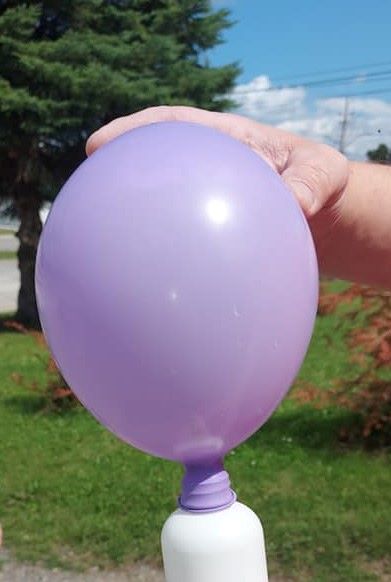
Did you know that you can blow up a balloon with baking soda and vinegar? Using a funnel, fill one of the bottles with a couple inches of vinegar. Then insert another funnel into the mouth of the balloon and fill it with a few spoonfuls of baking soda. Next, secure the mouth of the balloon over the mouth of the bottle. While holding the bottle, lift the end of the balloon and allow the baking soda to drop into the bottle. We watched in amazement as the balloon magically inflated.
Diet Pepsi & Mentos Balloon Experiment
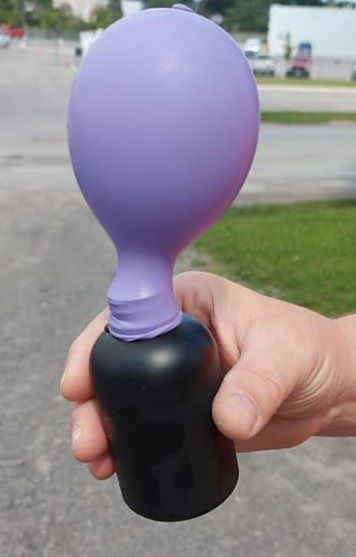
We also did this same experiment using Pepsi and Pop Rocks, Pepsi and Mentos.
Using a funnel, fill one of the bottles with half a can of soda. Then fill the balloon with Pop rocks, nerds or mentos. Next, secure the mouth of the balloon over the mouth of the bottle. While holding the bottle, lift the end of the balloon and allow the candy to drop into the bottle of soda. The results are an inflated balloon.
Melted Crayon Painting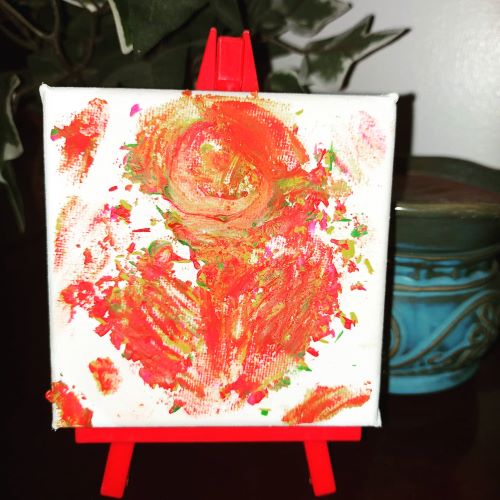
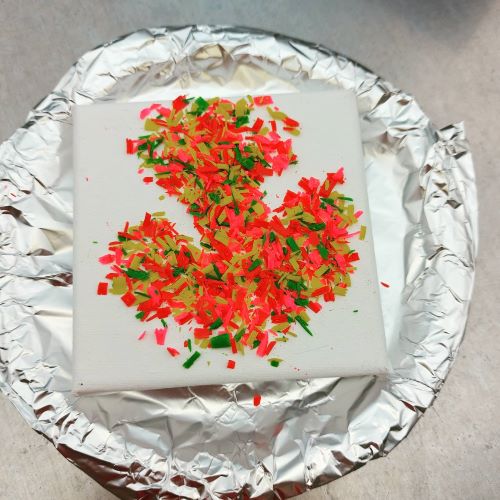
You will Need:
- Small Canvas
- Crayon Bits
- Pencil
Break the crayons into small pieces. I recommend grating the crayons to help them melt quicker in the sun. Arrange crayons on black canvas. Place foil over a plate and sit the canvas on the plate in direct sunlight. Once melted you can use a pencil to make a design. After ten minutes inside your canvas should be dry and ready to display. You can also speed up the process by placing your crayon art in a hot car. We tried this experiment and after about an hour, they were all the way melted. This is a good way to teach kids how incredibly hot the inside of a car can get on a Summer day.
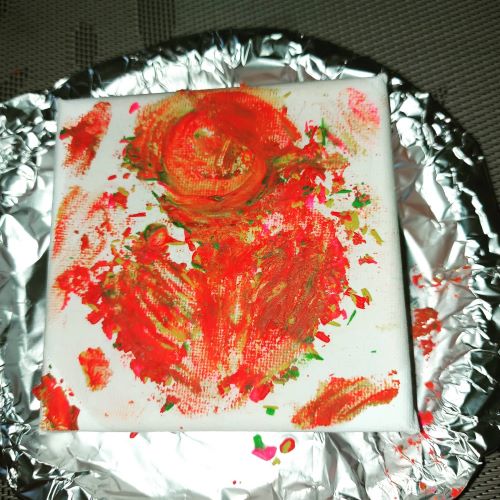
We hope you enjoy these projects from Griddly Games as much as we did!
About Griddly Games:
Griddly Games get you going. The company, based in Richmond, near Vancouver, British Columbia, creates award-winning games and activity kits for kids that deliver innovative, engaging fun that brings people together. Founded in 2007 by Reisa Schwartzman, a mother of three boys, who took it upon herself to deliver wholesome family fun that multiple ages could enjoy at once, Griddly Games offers products that inspire laughter and fun, while promoting an active and healthy lifestyle. Griddly Games instill a strict company philosophy to encourage social interaction, learning, strategy and challenges that anyone (from across the grid) can enjoy. To discover more about Griddly Games, visit www.griddlygames.com and get all of the most up-to-date, immediate information by interacting with the company on Twitter, Facebook, Instagram and YouTube.
